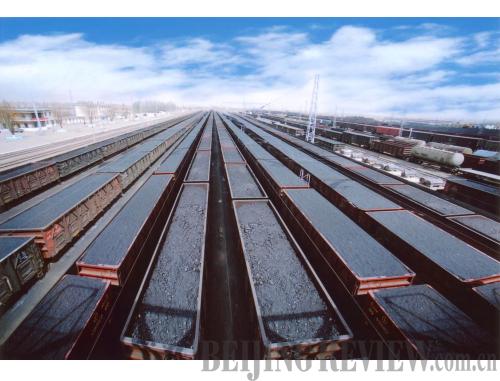|
 |
|
PRIMARY PRODUCER: At a railway station in Datong, Shanxi, trains transport coal out of the province. Shanxi is China's richest coal province, accounting for more than one third of the country's coal reserves (XINHUA) |
Shanxi Province, which suffers the most serious pollution in China, has put in motion plans to reorganize its coalmining industry, seeking to reduce the number of coal companies from 2,200 to 100. The plan calls for the closing of small coalmines with backward production conditions and low productive capacities by "making the large ones acquire the small ones and making the strong ones acquire the weak ones."
Already the policy has drawn critical responses and challenges from across the country. A majority of the resistance has come from the privately owned coalmining sector, since most of the small coalmines that would be closed or merged are not state owned. The policy has been criticized as "state capitals advance but private capitals retreat." Moreover, because many of the owners of private coalmines are from Zhejiang Province, where private economy is the most active, the policy launched by Shanxi has also aroused fierce argument among economists in both provinces.
A necessary policy?
The Shanxi coalmine reorganization process can be regarded as reform strongly promoted by the local government.
Shanxi is China's richest coal-producing province, with its coal reserves accounting for more than one third of the country's total and contributing one fourth to the country's overall coal output. Nearly 50 percent of China's coal exports come from the province.
To stimulate economic development, Shanxi previously sold the rights of coalmine exploitation, resulting in mining operations of different sizes spreading across the province. The number of coalmines in Shanxi once peaked at 10,000.
While contributing significantly to local economic development, the coalmines are also responsible for some disadvantages, including low utilization efficiency of resources, serious environmental pollution and frequent accidents.
According to figures released by the provincial government in 2007, 70 percent of coalmine accidents occurred in small coalmines with a death rate 17.8 times greater than that in large coalmines. The rate of resource recovery in small coalmines is also a cause for concern, sitting at about 15 percent, one fourth of the advanced level. That is to say, if small and medium-sized coalmines produce 350 million tons of coal every year, they may waste 1 billion tons of coal resources.
These problems are not limited to Shanxi Province. On November 21, a severe mine accident occurred at the Xinxing Mine of northeast Heilongjiang Province, claiming 107 lives as of November 25.
Shanxi has put considerable effort into solving the problem, especially by closing coalmines where accidents occurred. By the end of 2008, the number of coalmines in Shanxi had been reduced to 2,598, but more than 70 percent of the existing coalmines have a production capacity of 300,000 tons or below.
The most serious matter bothering officials in Shanxi is environmental pollution—in the past 10 years, losses to the local ecology caused by extensive exploitation of coalmines has amounted to 500 billion yuan ($73.21 billion).
To redeem the coalmining industry's less-than-perfect performance record, at the outset of 2009 Shanxi Province issued a plan to readjust and revitalize the coal mining sector. According to the plan, by the end of 2010 the number of coalmining companies in the province will have been reduced from 2,200 to about 100, and the number of coal mines will be reduced from 2,598 to 1,000.
After reorganization, the annual output of each coal mining company should not be lower than 3 million tons, with the annual output of a single coal mine not being lower than 900,000 tons, a production scale the provincial government thinks is reasonable. Big coal mining companies will play a key role in the reorganization, while small and medium-sized coalmines can merge at their own will, as long as the reorganized company conforms to the scale requirements of the government plan.
| 